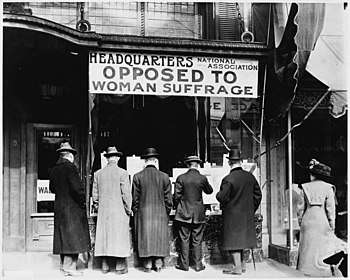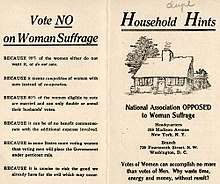National Association Opposed to Woman Suffrage
The National Association Opposed to Women Suffrage (NAOWS) was founded in the United States by women opposed to the suffrage movement in 1911. It was the most popular anti-suffrage organization in northeastern cities.[1] NAOWS had influential local chapters in many states, including Texas and Virginia.

History
The National Association Opposed to Women Suffrage (NAOWS) was established by Josephine Jewell Dodge in New York City in 1911.[1] Dodge had the first meeting at her house and women came from New York and surrounding states.[2] Dodge was currently the president of the New York State Association Opposed to Woman Suffrage (NYSAOWS).[3] Dodge resigned from NYSAOWS to take over as president of NAOWS.[4] Shortly after formation, state branches of NAOWS began to form.[5][6] Headquarters in Washington, D.C. were opened in 1913, giving the organization a front in both New York and the U.S. Capital.[7][8]
Like other anti-suffrage organizations, NAOWS published a newsletter as well as other publications, containing their opinions on the current political issues of the time. The newsletter of the association was called Woman's Protest (later renamed Woman Patriot in 1918).[9] Dodge also toured the country, spreading anti-suffrage views to other states.[10]
Members of the NAOWS typically belonged to wealthy families who feared suffrage would upset the status quo.[11] In the South, the NAOWS gained support from many plantation owners who believed rights for women would lead to rights for minorities. Josephine Dodge, the founding president, was replaced in 1917,[12] by Alice Hay Wadsworth, wife of U.S. Senator James W. Wadsworth, Jr. from New York.[13] Upon amendment to the New York State Constitution granting women the right to vote, the focus of the NAOWS shifted from the state level to the federal level. The organization also began to see more men join NAOWS than before.[14] The headquarters were moved solely to Washington D.C. and they merged with the Woman Patriot Publishing Company.[15] The organization disbanded in 1920 as a result of the passage of the Nineteenth Amendment.[16]
Texas Association Opposed to Woman Suffrage
In March 1916, the Texas Association Opposed to Woman Suffrage (TAOWS) was created as a chapter of NAOWS in Houston with Pauline Wells as the president.[17][18] The chapter in Texas also connected the increase in African Americans voting to women's suffrage and they stoked fears of "domination by the black race in the South."[17] They also believed that women's suffrage was linked to "feminism, sex antagonism, socialism, anarchy and Mormonism."[17] Like their parent organization, TAOWS had local chapters in major Texas cities.[19] TAOWS fought against the Texas Equal Suffrage Association who were pushing for Texas women's right to vote in Texas primary elections in 1918.[17] In April 1919, headquarters were moved to Fort Worth.[20] In 1919, TAOWS successfully campaigned against a state measure for women's vote which was defeated by 25,000 votes in May.[17] However, in June 1919, Texas passed a suffrage amendment, allowing women to vote and the TAOWS stopped fighting against women's suffrage.[17]
Virginia Association Opposed to Woman Suffrage
A group, the Virginia Association Opposed to Woman Suffrage (VAOWS) formed in Richmond in March 1912 and affiliated with NAOWS.[21] Jane Rutherford served as the president of VAOWS.[22] Local branches in different cities formed by 1913 and the organization distributed anti-suffrage literature.[23][24] In 1915, VAOWS helped raise money for the Belgian Relief Fund during World War I.[25] By May 1917, VAOWS had doubled in size and continued to grow through 1918.[26][27] Around 8,000 women had signed up with the anti-suffrage cause in Richmond by 1919.[28]
Like the Texas Association Opposed to Woman Suffrage, VAOWS also suggested that race riots, the black vote and women's suffrage were connected.[28] In a sponsored editorial published in The Richmond Times-Dispatch on September 2, 1919, VAOWS exclaimed, "Race riots will increase if there is more politics between the races and if women are mixed up in politics!"[28]
Political views

One of NAOWS' publications included a pamphlet, Some Reasons Why We Oppose Votes for Women,[29] which, as the title suggests, outlines some of the reasons why they are opposed to women suffrage. They believed it was irrelevant to the success of the country, as stated in their pamphlet:
"Because the great advance of women in the last century— moral, intellectual and economic— has been made without the vote; which goes to prove that it is not needed for their further advancement along the same lines."[29]
The National Association Opposed to Women Suffrage opposed women's right to vote because they said that the majority of women did not want the right to vote,[30] and because they believed that the men in their lives accurately represented the political will of women around the United States. NAOWS submitted pamphlets like these to the general public as well as directing them to government officials so that political figures would see that women opposed the then-unratified nineteenth amendment. They did this in order to counteract the rhetoric of the suffragettes of the time. According to the NAOWS and the state-based organizations that it inspired, voting would severely and negatively affect the true submissive and domestic state of the feminine. These organizations were championed by women who thought themselves the prime examples of true womanhood—quiet, dignified, and regal. They looked with disdain at the outward protests of suffragettes.
NAOWS wanted to appeal to conservative and traditional members of their community, including other women and religious figures.[31] They positioned themselves as being in opposition of "the militant suffragette" and militant or "hysterical" tactics.[32][33] NAOWS also believed that women's involvement in politics would interfere with their "civic duties for which they are peculiarly adapted."[2] NAOWS believed that women were equal to men, but had different duties and "functions."[34]
Quotes from Some Reasons Why We Oppose Votes For Women
"We believe that political equality will deprive us of special privileges hitherto accorded to us by law."[29]
"[We oppose suffrage] Because it means simply doubling the vote, and especially the undesirable and corrupt vote of our large cities." [29]
"[We oppose suffrage] Because our present duties fill up the whole measure of our time and ability, and are such as none but ourselves can perform."[29]
Notable members
References
Citations
- Lange, Allison (Fall 2015). "National Association Opposed to Woman Suffrage". National Women's History Museum. Archived from the original on 23 October 2017. Retrieved 10 May 2018.
- "National Anti-Vote Society". Chicago Tribune. 19 November 1911. Retrieved 2018-05-10 – via Newspapers.com.
- Goodier 2013, p. 44.
- "The new president of the State Asso-". The Brooklyn Daily Eagle. 9 December 1911. Retrieved 2018-05-10 – via Newspapers.com.
- "Report of Work of Anti-Suffragists". The Brooklyn Daily Eagle. 1 March 1912. Retrieved 2018-05-10 – via Newspapers.com.
- "Anti-Suffrage Meeting". Norwich Bulletin. 23 November 1912. Retrieved 2018-05-10 – via Newspapers.com.
- "Anti-Suffragists Ready". The Courier-Journal. 19 February 1913. Retrieved 2018-05-10 – via Newspapers.com.
- "Hits Votes for Women". The Philadelphia Inquirer. 14 March 1913. Retrieved 2018-05-11 – via Newspapers.com.
- "National Association Opposed to Woman Suffrage". Encyclopedia Britannica. Retrieved 2018-05-10.
- "Antisuffragists Busy". The Tennessean. 14 February 1914. Retrieved 2018-05-12 – via Newspapers.com.
- Goodier 2013, p. 31.
- "Women Miffed at Suff Bill Quit Council". The Washington Herald. 27 December 1917. Retrieved 2018-05-13 – via Newspapers.com.
- Maddux, Kristy (October 2004). "When Patriots Protest: The Anti-Suffrage Discursive Transformation of 1917". Rhetoric & Public Affairs.
- Goodier 2013, p. 13.
- Marshall, Susan E. (2010). Splintered Sisterhood Gender and Class in the Campaign Against Woman Suffrage. University of Wisconsin Press. ISBN 9780299154639. OCLC 934667338.
- Cottrell, Debbie Mauldin (15 June 2010). "Texas Association Opposed to Woman Suffrage". Handbook of Texas Online. Texas State Historical Association. Retrieved 12 May 2018.
- "Mrs. Wells Expected". The Houston Post. 21 July 1916. Retrieved 2018-05-13 – via Newspapers.com.
- "Women Organize Local Branch To Oppose Suffrage". The Houston Post. 30 March 1919. Retrieved 2018-05-13 – via Newspapers.com.
- "State Campaign Against Suffrage Is On In Earnest". The Marshall Messenger. 18 April 1919. Retrieved 2018-05-13 – via Newspapers.com.
- "Women Oppose Women". Alexandria Gazette. 22 March 1912. Retrieved 2018-05-13 – via Newspapers.com.
- "Suffragists and Antis in Session". The Times Dispatch. 15 November 1912. Retrieved 2018-05-13 – via Newspapers.com.
- "Miss Davis the Head". The Times Dispatch. 2 August 1913. Retrieved 2018-05-13 – via Newspapers.com.
- "Opposed to Votes for Women". The Washington Post. 4 January 1914. Retrieved 2018-05-13 – via Newspapers.com.
- "Fund Goes to Belgians". The Times Dispatch. 15 January 1915. Retrieved 2018-05-13 – via Newspapers.com.
- "Many Join Antisuffragists". The Times Dispatch. 24 May 1917. Retrieved 2018-05-13 – via Newspapers.com.
- "Antisuffragists Gain in Total Membership". The Times Dispatch. 5 May 1918. Retrieved 2018-05-13 – via Newspapers.com.
- "Shall the State Surrender to the Anthony Amendment?". The Times Dispatch. Retrieved 2018-05-13 – via Newspapers.com.
- "Suffrage Collection, 1851-2009 (bulk 1880s-1920s) Finding Aid". Five College Archives & Manuscript Collections. Archived from the original on 29 January 2017. Retrieved 2018-05-10.
- "Marjorie Benton Cooke, for Votes for Women and Grace Duffield Goodwin, Opposed, the Winners". The Sun. 13 October 1912. Retrieved 2018-05-10 – via Newspapers.com.
- "Household Hints". Gender Issues and Sexuality: Essential Primary Sources. Thomson Gale. 2006.
- "Women Opposed to Suffrage Elect Officers". Newspapers.com. 29 December 1911. Retrieved 2018-05-10 – via Newspapers.com.
- "Mrs. Dodge Answers 'Militant' Speech". The Brooklyn Daily Eagle. 19 March 1912. Retrieved 2018-05-10 – via Newspapers.com.
- "Vote Fight Grows". Evening Star. 23 February 1913. Retrieved 2018-05-11 – via Newspapers.com.
- "Kate Douglas Wiggin". Aberdeen Herald. 15 January 1911. Retrieved 2018-05-10 – via Newspapers.com.
Sources
- Goodier, Susan (2013). No Votes for Women: The New York State Anti-Suffrage Movement. Ubana, Illinois: University of Illinois Press. ISBN 9780252094675.CS1 maint: ref=harv (link)
Further reading
- Freedman, Estelle B. (2003). No Turning Back: The History of Feminism and the Future of Women. Ballantine Books. ISBN 978-0345450531.